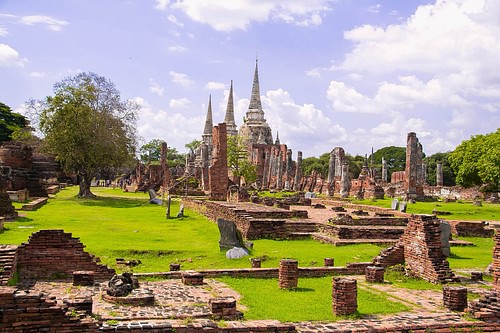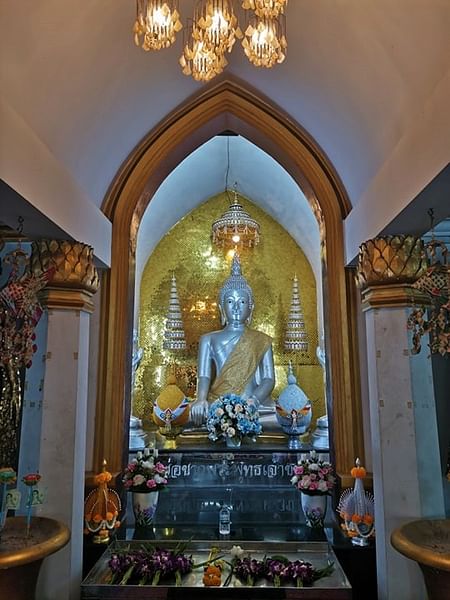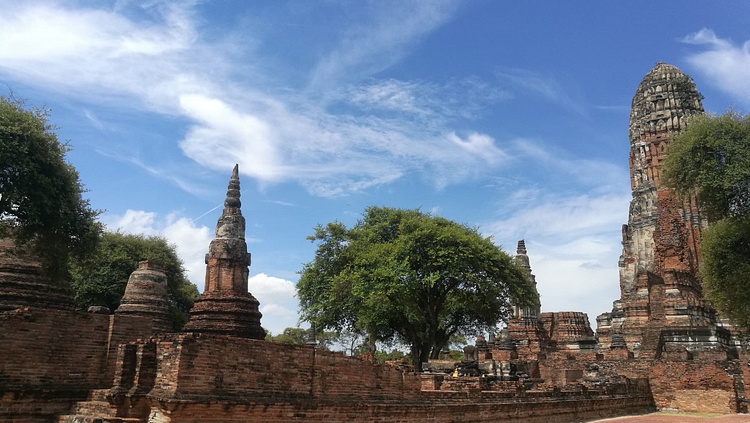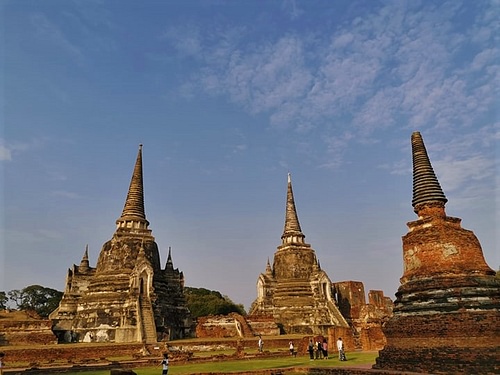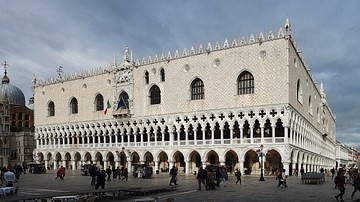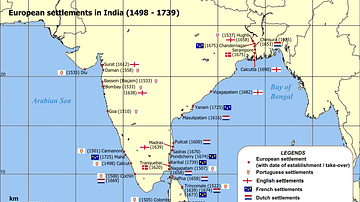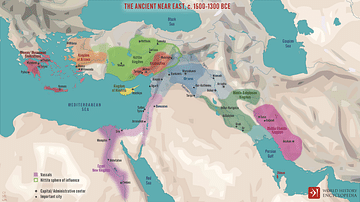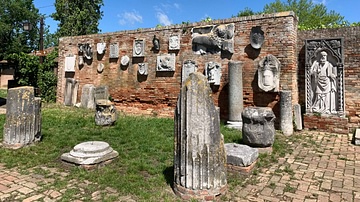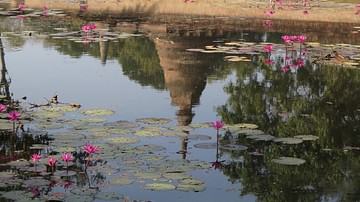The royal city of Ayutthaya (ah-you-tah-ya) was a small kingdom in Siam (modern Thailand), and it was an unrivalled commercial and maritime power from 1350-1767 CE. Ayutthaya became the second capital of Siam in 1438 CE when it absorbed the Sukhothai kingdom in northeast Thailand.
Ayutthaya is in the valley of the Chao Phraya River and is believed to have been established because of a smallpox outbreak. King Ramathibodi I (r. 1351-1369 CE), who was the first king of Ayutthaya, moved his court from the principality of Lop Buri in south-central Siam.
He set up his new city-fortress on a circular island in the Chao Phraya River at the confluence of three tributaries. This city was called Dvaravati Sri Ayudhya or more commonly Ayutthaya, a name that derives from Ayodhya in northern India - the city of the hero Rama in the Hindu epic Ramayana.
The people of Ayutthaya referred to themselves as Tai and the kingdom was known as Krung Tai in the Thai language. Ayutthaya formed close trading links with China by supplying exotic goods such as aromatics and ornaments and, in turn, the kingdom was a distribution centre (entrepot) for Chinese silks and ceramics.
History
Portugal was the first European nation to establish commercial contact with Ayutthaya in 1511 CE. Modern Thai cuisine and language reflect Portuguese influence (the Thai word for soap sbū̀, for example, comes from the Portuguese sabão). By the 17th century CE, Ayutthaya was a strong maritime power and a centre for global diplomacy. The Versailles court of Louis XIV (r. 1643-1715 CE) received Ayutthaya's foreign minister, Kosa Pan (1633-1699 CE), who was sent to France in 1686 CE to discuss the possibility of a military and trading alliance.
Ayutthaya also attracted some notable foreigners: the Greek adventurer, Constantine Phaulkon (1647-1688 CE), who became a trusted adviser to Narai the Great, king of Ayutthaya (r. 1656-1688 CE); French Jesuit missionary Father Guy Tachard (1651-1712 CE); and English merchant George White (1648 - c. 1707 CE) who was a co-founder of the reformed East India Company.
Ayutthaya was described as the Venice of the East by the Portuguese explorer Fernao Mendez Pinto (c. 1509-1583), but the city's 417-year dominance came to an end in 1767 CE when the Burmese army attacked and destroyed Ayutthaya, including most of its official records, art, and literature. The city's history and that of its 34 kings had to be pieced together from the accounts of foreign visitors and old maps.
What is left of the former kingdom are the ruins contained in the 289-hectare (714 acres) Ayutthaya Historical Park, which was declared a UNESCO world heritage site in 1991 CE. Taking a tour of this park reminds the visitor that Thai-style architecture with its temples that look like cakes piled high with cream owes much to the Ayutthayan period.
Before Your Visit
If you like taking Instagram-worthy photos, there is no better place to go than the Ayutthaya Historical Park. It is studded with the archaeological ruins of temples (wat in Thai) and monasteries, tall reliquary towers (prang), and bronze Buddha statues. You will even see the head of a Buddha image trapped in the roots of an overgrown Bodhi fig tree.
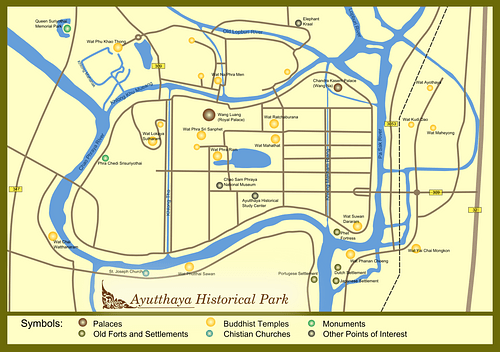
It is relatively easy to walk or bicycle around the old city due to Ayutthaya's grid planning system so you can wander around at leisure and soak up the history, but a fun way to get around is to rent a tuk tuk (Thai three-wheeled motorcycle taxi). If there are not too many tourists, it might feel as though you are walking or riding through a ghost town. You can also hire a personal tour guide who will provide additional historical insights.
Four Must-See Temples
The Ayutthaya Historical Park is 80 kilometres (49 miles) north of the capital city of Bangkok. Most of the temple ruins are located on the northwest of the island. Because there are over 60 temples and ruins to see, we will only visit four of the most intriguing or historically significant ones: Wat Phra Mahathat, Wat Ratchaburana, Wat Lokayasutharam, and Wat Phra Si Sanphet.
You can visit this site to research all of Ayutthaya's temple sites and also find out what has been restored.
Wat Phra Mahathat
Wat Phra Mahathat is located in front of the Grand Palace to the east, next to Pa Than Bridge, and is the first temple tourists usually head towards. It is called the Monastery of the Great Relic and was built during the reign of two kings: Borommaracha I (r. 1370-1388 CE) and King Ramesuan (r. 1388-1395 CE).
It is an important temple because it once housed some holy relics of Buddha. The Royal Chronicles of Ayutthaya (which are surviving fragments of Ayutthaya's history) say that King Ramesuan had a revelation and believed he should build a holy reliquary. Wat Phra Mahathat's central prang is where the holy relics of Buddha were kept, along with silver, gold, and valuable gems. The prang was thought to have originally been 50 metres (164 ft) in height and was built in the Khmer-style.
Wat Phra Mahathat was also a royal monastery and the seat of the Supreme Patriarch (the head of the order of Buddhist monks). The central prang collapsed during the reign of King Songtham (r. 1610-1628 CE) and was restored several times with four porticos being added and the height increased. When Ayutthaya was sacked by the Burmese in 1767 CE, the wat was reduced to ruins. The Burmese believed that lopping off the heads of Buddha images decreased their enemy's power, and many Buddha statues in Ayutthaya suffered this fate.
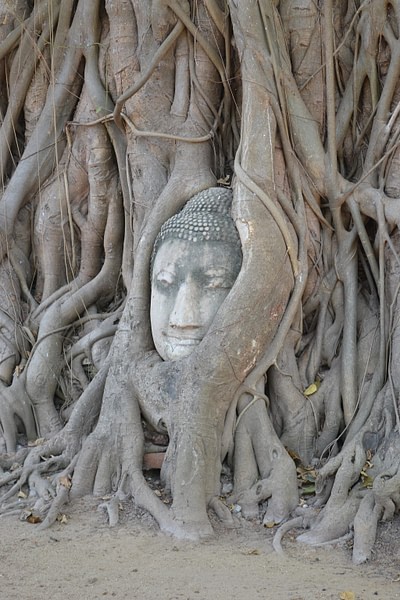
To get that Instagram-worthy photo, you will need to crouch down and make sure your head is not higher than the Buddha. Otherwise, the Thais will consider you to be disrespectful.
Wat Ratchaburana
Wat Ratchaburana is called the Temple of Royal Restoration and is opposite Wat Phra Mahathat. This temple was constructed in 1424 CE during the reign of Borommaracha II (r. 1424-1448 CE) and stood on the western bank of the Khlong Pratu Khao Pluak (a canal).
It is the oldest temple in Ayutthaya and was built on the site where the king's two older brothers were cremated following a power struggle between them after their father, King Intharacha, died in 1424 CE. The brothers fought on the backs of elephants, and their young brother, Chao Sam Phraya, was then invited to take the title of king. He built the temple to contain the ashes of his fallen brothers.
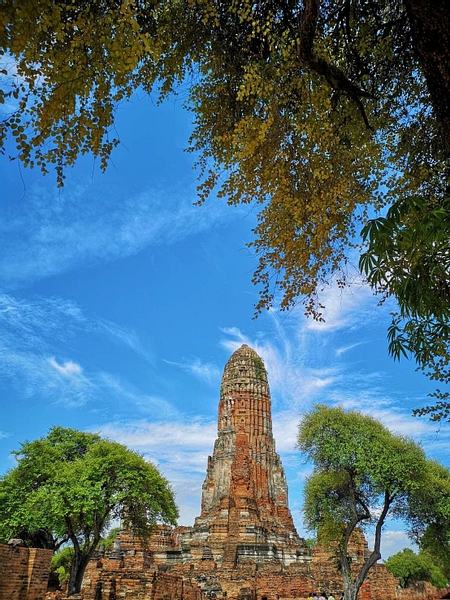
There was a central cella (hall) inside the main prang and this contained a two-level crypt with murals that was reached via three steep staircases. The staircases were restored in 1958 CE and are narrow, so if you suffer from claustrophobia it might be better to remain outside and imagine what the temple must have looked like in the early Ayutthayan period.
Wat Lokayasutharam
Thailand is famous for Buddha statues that are covered in saffron robes as a mark of respect. One of the best-known Buddha images is in the Temple of the Emerald Buddha in the grounds of the Grand Palace in Bangkok. The seated Buddha's clothes are changed by the Thai King every season.
But the Ayutthaya Historical Park has some magnificent Buddha images of historical significance, and the largest one is in the ruins of Wat Lokayasutharam in the northwest of the park. Known as the Temple of the Reclining Buddha, the brick and plaster statue is about 42 metres (137 ft) long and 8 metres (26 ft) high and is called Phra Buddhasaiyat.
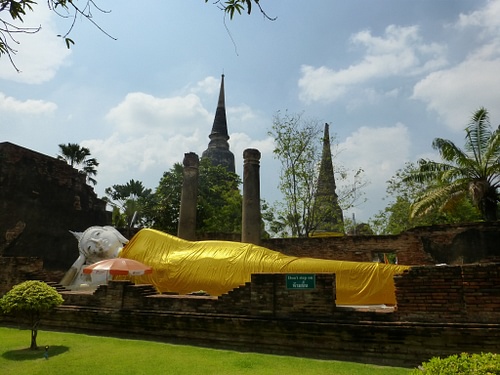
Fortunately, the Buddha survived destruction in 1767 CE, but since it is outside in all weather conditions, the Buddha image has been restored several times, most recently in 1954 CE and again in 1989 CE. Usually, a saffron cloth covers the Buddha and you will see Thai people and visitors pressing small squares of gold leaf onto the image. Gold is an important colour in Buddhism as it symbolises purity and enlightenment. By applying little pieces of gold leaf, the Buddhist or visitor is also hoping to obtain good karma or merit.
Head over to Wat Phananchoeng in Ayutthaya to see a massive gold Buddha that was constructed in 1334 CE and is 19 metres (62 ft) in height.
Wat Phra Si Sanphet
This temple, which was used as a model for the Temple of the Emerald Buddha, was built in 1492 CE in the grounds of the former royal palace. It was known as the King's Temple since it was used by the royal family for ceremonies. The restored three main chedis contain the ashes of three Ayutthayan kings - King Borommatrailokanat (r. 1448-1488 CE) and his two sons. King Borommatrailokanat was the first Thai king to own a rare white (albino) elephant.
A viharn was built at Wat Phra Si Sanphet in 1499 CE to house a golden Buddha that was covered with more than 150 kilograms (330 pounds) of gold and stood at a height of 16 metres (53 ft). When the temple was destroyed, the Burmese melted down the gold and only the three Ceylonese-style chedis were left standing.
10 Fun Facts
If you decide to explore Ayutthaya on your own, here are ten fun facts that will give you more historical knowledge:
- Ayutthaya used cowrie shells as currency.
- The sakdi na system used by Ayutthaya assigned units of land (usually rice fields) to each social class. The size of the unit was decided by the king and determined the rank within each social class. Slaves, for example, were worth five units while the king was worth 100,000 units.
- In the king's presence, phrai luang (royal servants) were required to say they were dust at His Majesty's feet.
- Wat Ayodhya at Ayutthaya is a temple used today by the Buddhist clergy.
- After the Burmese left, the city was reclaimed by the jungle, but by the early 19th century CE, treasure hunters were busy digging and unearthing valuable artefacts. Even today, treasure hunters search the depths of the Chao Phraya River as it was the gateway into Ayutthaya used by Portuguese, Spanish, Dutch, and Chinese traders.
- King Naresuan (r. 1590-1605 CE) was riding an elephant into battle when his elephant stumbled over the roots of a jujube tree (pud sa in Thai). The king expressed his gratitude by ordering jujube trees to be planted around the royal palace. Walking around Ayutthaya today, you can rest in the shade provided by hundreds of jujube trees.
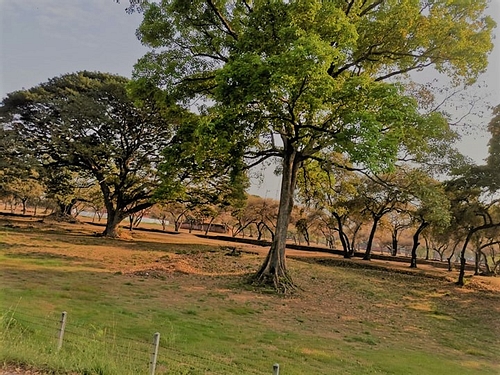 Jujube Tree
Jujube Tree - The Portuguese established a settlement at the southern end of Ayutthaya in 1540 CE, and it was home to soldiers, traders, and priests. The population grew to around 3,000 but the settlement was not spared by the Burmese in 1767 CE. The ruins of the Portuguese village include the Dominican church, which was excavated and found to contain 200 skeletons.
- By 1700 CE, Ayutthaya was one of the largest cities in the world and was said to have over 1,000,000 inhabitants.
- At Wat Lokayasutharam, all the toes of the reclining Buddha are of equal length.
- Foreigners (farang in Thai) were not allowed to live inside Ayutthaya's walls.
How to Get There
You can take a day trip to Ayutthaya, but there is so much to see why not stay for a night or two? There are many hotels and homestays within walking distance of the historic park. Travel from Bangkok by riverboat, mini-bus or car, but the train is the most scenic and relaxing way to travel to Ayutthaya. Trains depart regularly from Bangkok's Hualamphong station.
The park is open from 8.00 am to 6.00 pm and there is no entrance fee to the park itself. The major temples do charge, and the cost is around 50 Thai Baht (USD 1.55).
The best time to visit is December or January when the heat is not so relentless. On any visit, make sure to follow appropriate dress code (long pants or skirts, no bare shoulders, and remove your shoes before entering a temple).
After you have walked around for hours taking in the history, try some giant river prawns grilled over charcoal at one of Ayutthaya's restaurants. Nothing better.
